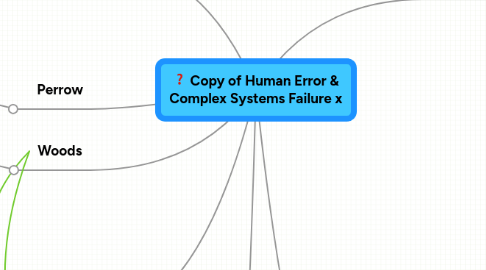
1. Reason
1.1. Human Error vs. Violation
1.1.1. Error Management
1.1.1.1. Error Detection
1.1.1.1.1. Capture Error
1.1.1.2. Error Tolerance
1.1.1.2.1. Swiss Cheese Model
1.1.2. Phenotype vs. Genotype of Error
1.1.3. Active vs. Latent Error
1.1.3.1. Active
1.1.3.1.1. Skill-based
1.1.3.1.2. Rule-based
1.1.3.1.3. Knowledge-based
1.1.3.2. Latent
1.1.3.2.1. Mistakes
1.1.3.2.2. Slips
1.1.3.2.3. Lapses
2. Perrow
2.1. Normal Accidents
2.1.1. Coupling
2.1.2. Complexity
2.1.2.1. Linear Interacts vs. Complex Interactions
2.1.2.1.1. Complex
3. Woods
3.1. Resilience Engineering
4. Weick
4.1. Traditional vs. New View of Reliability
4.1.1. New
4.1.1.1. HROs
4.1.1.1.1. Mindfulness
5. Wickens
5.1. Characteristics of Naturalistic/Recognition-primed Decision Making
5.1.1. Heuristics
5.1.1.1. Anchoring Heuristic
5.1.1.2. Availability Heuristic
5.1.2. Biases
5.1.2.1. Confirmation Bias
5.1.2.2. Overconfidence Bias
5.1.2.3. Hindsight Bias
5.1.2.4. Change Blindness
5.2. Attention
5.2.1. Exogenous vs. Endogenous
5.2.2. Top-Down vs. Bottom-Up
5.2.3. Knowledge & Data-driven Attention Allocation
6. Selective, Focused, Divided Attention
6.1. Directed Attention
6.1.1. Gestalt Theory & Gestalt Laws
6.1.1.1. Proximity-Compatibility Principle
6.1.1.2. Configured Display
6.1.1.3. Color Coding
6.1.1.4. Emerging Features
6.2. Visual Sampling
6.2.1. Foveal Vision
6.2.2. Dwell Time
6.2.3. Saccade vs. Fixation
6.3. Signal Detection Theory
6.3.1. Pursuit vs. Saccadic Eye Movements
6.3.2. Supervisory Sampling vs. Target Search
7. Leveson
7.1. Domino Model
7.2. Fault Tree Analysis
7.2.1. Goal- vs. Motive-based explanation
7.3. Chain of Event Models
7.3.1. Determinants of Stopping Rule
7.3.1.1. System vs. Component Failure Analysis
